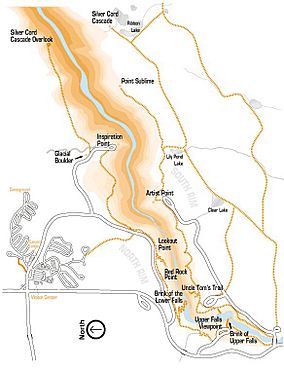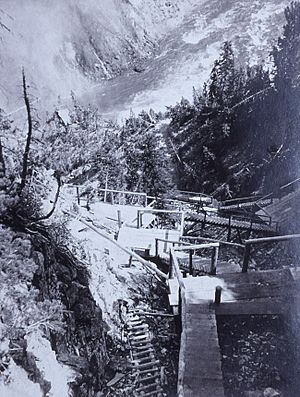Grand Canyon of the Yellowstone facts for kids
Quick facts for kids Grand Canyon of the Yellowstone |
|
|---|---|

Grand Canyon of the Yellowstone and Lower Falls
|
|

Map of upper canyon
|
|
| Location | Canyon, Yellowstone National Park, Wyoming |
The Grand Canyon of the Yellowstone is an amazing natural wonder located in Yellowstone National Park in Wyoming. It's the first big canyon you see along the Yellowstone River, right after the famous Yellowstone Falls. This canyon is about 24 miles (39 km) long. It's also very deep, reaching between 800 and 1,200 feet (240 to 370 meters) down. The width of the canyon varies from 0.25 to 0.75 miles (0.40 to 1.21 km).
Contents
Exploring the Grand Canyon of the Yellowstone
People knew about this canyon for a long time, even before it was officially explored. Trappers and prospectors who visited the Yellowstone area had seen it. But the first detailed descriptions came from special trips. These were the Cook–Folsom–Peterson Expedition in 1869 and the Washburn-Langford-Doane Expedition in 1870.
Charles W. Cook was one of the first to write about seeing the canyon. He rode ahead of his group on September 20, 1869. He was amazed when his horse suddenly stopped at the edge of the huge canyon. He later wrote that he and his friends were speechless for about five minutes. They were just taking in the incredible view.
A year later, in 1870, Lieutenant Gustavus C. Doane described the canyon with more scientific details. He wrote about the loud roar of the falls as they got closer. He also mentioned finding many different kinds of rocks in the canyon. These included quartz, granite, and even obsidian. Doane was very impressed by the canyon's colors and unique features. He noted how deep it was and how tall the trees on the edge looked from below.
In 1890, a man named H.F. Richardson, also known as Uncle Tom, got permission to help tourists. He would take them down into the canyon near the Lower Falls. This path became known as Uncle Tom's Trail. The original trail is gone, but there's still a steep stairway. It leads down to the base of the Lower Falls and is still called Uncle Tom's Trail. It's about a 3-mile (4.8 km) hike.
Cool Places to See in the Canyon
- Agate Creek 44°51′01″N 110°21′38″W / 44.85028°N 110.36056°W
- Artist Point 44°43′16″N 110°28′46″W / 44.72111°N 110.47944°W
- Calcite Spring 44°54′24″N 110°23′42″W / 44.90667°N 110.39500°W
- Cascade Creek 44°43′00″N 110°29′58″W / 44.71667°N 110.49944°W
- Inspiration Point 44°43′31″N 110°28′13″W / 44.72528°N 110.47028°W
- Grand View 44°43′36″N 110°28′48″W / 44.72667°N 110.48000°W
- Lookout Point 44°43′24″N 110°29′03″W / 44.72333°N 110.48417°W
- Overhanging Cliff 44°53′44″N 110°23′22″W / 44.89556°N 110.38944°W
- Point Sublime 44°43′28″N 110°27′39″W / 44.72444°N 110.46083°W
- Seven Mile Hole 44°45′13″N 110°24′16″W / 44.75363°N 110.40450°W
- Silver Cord Cascade 44°43′34″N 110°27′06″W / 44.72611°N 110.45167°W
How the Canyon Was Formed: Geology Facts
The Grand Canyon of the Yellowstone was mostly shaped by the Yellowstone River. It was not carved out by glaciers. About 600,000 years ago, a huge volcano erupted here, forming the Yellowstone Caldera. This eruption covered the area with lava flows. The land also lifted up, creating cracks or faults. These faults made it easier for the river to wear away the rock quickly.
Even though glaciers covered the area many times during ice ages, they didn't carve the canyon. Any glacial deposits that filled the canyon were later washed away. This means there's little proof they were ever there.
The area below the Lower Yellowstone Falls was once a geyser basin. This happened because of lava flows, faults, and heat deep underground. This heat is linked to a "hot spot" under Yellowstone. No one knows exactly when this geyser basin formed. But it was likely there during the last ice age. The heat and chemicals from the geysers changed the rock, making it soft and easy to erode. It's like baking a potato!
You can still see signs of this heat today. There are active geysers and hot springs in the canyon. The Clear Lake area, south of the canyon, is also fed by hot springs. It's another leftover from this ancient activity.
Ken Pierce, a geologist from the United States Geological Survey, explains more. About 14,000 to 18,000 years ago, at the end of the last ice age, ice dams formed. These dams were at the mouth of Yellowstone Lake. When the ice dams melted, a huge amount of water rushed downstream. This caused massive flash floods. These floods quickly and powerfully carved out the canyon we see today. These floods probably happened more than once. The canyon has a classic V-shape, which shows it was formed by a river, not by glaciers. The Yellowstone River is still eroding the canyon even now.
Why the Canyon Has So Many Colors
The amazing colors in the canyon are also due to the heat and chemicals. The rock in the canyon contains different types of iron. When the old geyser basin was active, the heat "cooked" these iron compounds. This caused chemical changes. When the rocks were exposed to air and water, they changed colors. The rocks are actually rusting! The colors show if water is present in the iron compounds. Most of the yellow colors come from iron in the rock. Many people think it's sulfur, but it's mostly iron.
Images for kids
![]() This article incorporates public domain material from websites or documents of the National Park Service.
This article incorporates public domain material from websites or documents of the National Park Service.




